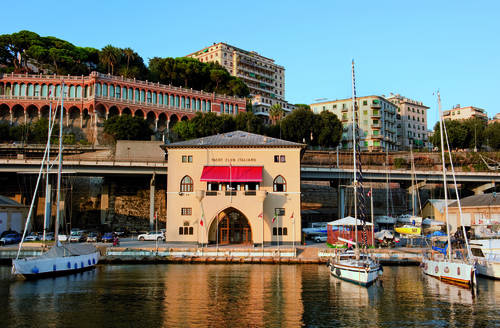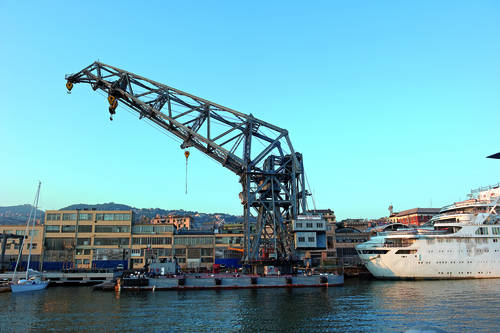Genoa: industrial archaeology and new architecture

Liberty palace, Italian Yacht Club | © Sagep archive | Patrizia Traverso | 2014
In this tour you can see how many changes you can find in an industrial area such is Genoa Harbour. In this specific case our guide will show how the architectural appearance was changed during last century; and how palaces, work areas and docks, crane and lifting machines remains till operating in the changing world of 1900. In particular, from the mirador of Galata Museo del Mare (you’ll enter in the museum only to reach the roof terrace) your guide will show the operation of single cranes or lifting machines. He will explain how these machines can work up nowadays contributing in the daily operations of stowage of goods. Genoa Harbour will show you the most interesting and peculiar aspects of one of Europe’s largest working harbours. In Genoa Harbour many areas have undergone great changes, the work has been streamlined, technology has witnessed the change by improving the performances, but notwithstanding this lifting machines continue their ancient work.
The Aquarium of Genoa was built inside the ancient dock-lands and redesigned by architect Renzo Piano in 1992, this area is now the city’s most popular tourist attraction. Populated by seals, dolphins, sharks, penguins and fish of all kinds and colours, you can see the Acquario di Genova (one of the largest and most visited in Europe). The aquarium offers wonderfully interesting discovery tours of the enchanting depths of the sea world that are well worth trying. Other worthy attractions in the same area are the Bigo panoramic elevator, the Biosphere and the Città dei Bambini, a museum-cumplay area for children aged between 2 and 14. The Town Gate known as Porta Siberia, (at the end of you tour) is dedicated to the work of the famous Genoese stage designer Lele Luzzati. A boat trip is ideal if you would like to get a different, more privileged view of this enchanting city by sweeping the coast from the Porto Antico (Ancient harbor).

Floating crane Langer-Heinrich |© Sagep archive | Patrizia Traverso | 2014
The historical maritime heritage is testimony of our civilization and is recognized by the cultural norms of our country so It must be preserved and, if possible, restored.
The Old Port of Genoa is a centuries- port structure that keeps inside the important traces of its transformations:
– From the warehouses of the medieval rooms to cotton warehouses of end ‘ 800;
– By the sea walls of the ‘ 500 to the octroi fences of ‘ 900;
– The remains of the seventeenth century to the piers of the 800 dry docks;
– The first crane in hand to the iron mammoth crane 900.
Its symbols, both viable and can be visited, are the lighthouse (built in the twelfth century and rebuilt in the XVI) and Palazzo San Giorgio, now headquarters of the Port Authority, which tells in his buildings, beautifully restored and re-invented in the nineteenth century, a history dating back to the Middle Ages

Hydralic crane Calata Mandraccio | © Sagep archive | Patrizia Traverso | 2014
DETAILS
07.30: departure by bus from Milan
10.00: arrival in Genoa and division into two groups
Group 1 – Genoa city: an open-air museum
Group 2 – Genoa: industrial archaeology and new architecture
12.00: Light Lunch at the Imperial Palace
14.00: Palazzo Tursi – welcome remarks and visit to the violin of Paganini
15.00 to 17.30: free time
17.30: departure